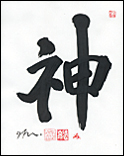We’ll take a look at the first line of Genjo Koan to explore some aspects of the translator’s assumptions and tasks.
The first phrase is:
諸法の仏法なる時節
Got that? Or not? Maybe it’s because you cannot read Japanese. Note—I’m assuming that. I’m assuming the reader cannot read Japanese characters and that therefore I need to do something about it. If I did not make that assumption, there would be no translation task. We want to provide something you can understand, at some level, and clearly given its unfamiliar script the original Japanese is not that, for you the Western reader. We’ve now made our first assumption. I’m highlighting this obvious point to emphasize that assumptions run throughout the translation process. They are assumptions about our readership, their capabilities, their interests.
To address this first problem, we’ll perform “transliteration”: converting one writing system to another. A standard transliteration would then give us:
shohou no buppou naru jisetsu
Got that? Or not? Maybe it’s because you cannot understand the words. There’s another assumption—that the reader cannot understand Japanese words and that therefore I need to do something about it. This is the second assumption necessary to provide something usable to the Western reader, another assumption about their capabilities.
To address this second problem, we’ll perform “translexicalization”—converting one set of words to another. That would yield:
all-law subject-particle Buddha-law be time
Got that? Or not? Maybe it’s because you cannot understand the grammar (syntax). Again, I’m assuming the reader cannot understand Japanese syntax and that therefore I need to do something about it. This is our third assumption. To address this third problem, we’ll perform “transsyntaxification”—converting one grammar to another. That gives us:
When all-law be Buddha-law
Aha, we now see something that resembles English. Some people would already call this a “translation”, although perhaps Nabokov’s term “transposition” would be more appropriate. We could actually publish this and plausibly claim it was English, and that we had “translated” it. But do you really get this? Or not? I’ll assume that you cannot understand the terms “all-law” and “Buddha-law”, which we went to such trouble to “translate”.
To make this “understandable”, we need to do something with these words. Leaving aside “all” for the time being, the “law” is the translation of Japanese 法 (hou), which we know comes from the Chinese, which we know is a translation of the Sanskrit dharma. So we can translate this as “all dharmas”, and the Buddha-law part as “Buddha-dharma”. Now we get:
When all dharmas are Buddhadharma
which actually looks like real live English as written by a real Zen master and seems really deep too. It’s a translation. But do you get that? Or not? Maybe it’s because you still cannot understand the words. This is yet another, fifth assumption—that such words are meaningless to the typical English reader. I’m assuming the reader cannot understand “dharma” and that therefore I need to do something about it. This assumption should be no more controversial than the first four, but yet it’s one which many scholars refuse to make.
Of course, many knowledgeable Buddhists in the West will understand “dharma”, or at least think they do. So if I was translating for them, this might be an OK translation, Problem is, they represent about 0.001% of all the people in the world that are potentially interested in what this is saying. What about the other 99.999%? We don’t care about them? Or maybe they should just learn Buddhist terminology first? Dogen was writing for 99% of Japanese people. Is it OK that I should randomly decide that it’s OK to arbitrarily change Dogen’s assumption about his audience? No, I should also come up with an English translation that addressed 99% of people, like Dogen was.
To stop at this point and say that the “dharma” translation is “correct” or “loyal” or “strict” is a copout. It’s just being lazy. By doing so, I would be violating Dogen’s implicit audience assumption. Until I do something about “dharma”, I still don’t really have a “translation”, but a “trans-literal-posi-syntactico-lation”. Of course, if that’s all I’m trying to represent it as—fine. If I lack confidence in what Dogen might have been trying to say and am trying to cover my ass—fine. But do we really want “cover-your-ass” translations?
To make this into a true translation—an expression that maps to the mental images and behavioral impact of what Dogen said—we have to go deeper. This is where some people get cold feet, saying this is going beyond “translation” and entering the realm of “interpretation”. Come on. Every single person that reads Dogen’s words is interpreting them. It’s certainly not unreasonable to ask the translator, presumably well-informed, to participate in this interpretive process.
So to make “all-law” meaningful to Westerners, what should we do with the “law” (法 dharma)? Some Buddhist dictionaries list as many as several dozen meanings of the term. But it’s a fair guess that in this case the meaning is “phenomena” or “things”. So we have “many things”, which is indeed how Tanahashi translates this.
But what about “Buddha-dharma”? Tanahashi translates this as is—a major copout; he might as well have left it in the original Japanese characters. Cleary gives us “Buddha-teachings”, which seems to be going too far. Neither translation reflects the 法 common to 諸法• and 仏法. That would seem to be a major oversight. Whatever we want to do with Dogen, we should respect his style, and in this crucially important first phrase of the first sentence in the first chapter of his magnum opus Shobo Genzo he explicitly chose wordings which shared the word 法 (hou, dharma). Certainly this is something we should respect.
Are we there yet? Certainly, Dogen intended for his writings to “mean” something, even if only for himself, as one Dogen scholar I recently met indicated the possibility of. “Mean” for whom? For the people that read them. Dogen was certainly sophisticated enough that he knew that a wide range of people would read his works, and presumably wrote them so that all could “understand” them. It would not surprise me if Dogen intuited that people from the 21st century would read his essays, including people from other cultures—given his experience in China, he was certianly aware of cross-cultural issues. Our duty, then, in translating Dogen, is to realize his vision and produce a version of his thoughts which is meaningful across centuries and cultures. And translating literally using terms such as “buddha-dharma” clearly fails that test.
Here in the West, we have the concept of “God”. No-one knows exactly what it means, but in a way everyone does. It refers to something external, if you prefer, or something internal, if you prefer, an unknown essence. This is precisely the sense of the “buddha” in Dogen’s “buddha-dharma” phrase. In other words, “buddha-dharma” refers to God’s law, or things of God. As such, that is exactly how it should be “translated”. That is why I insist that “shohou no buppou naru jisetsu” should be translated exactly as
when all things are God’s things
That is what Dogen “meant”. It is not “interpretive”. It is the precise expression of Dogen’s intent, to the extent possible, in modern English.
There is one additional step which is possible and desirable: to fine-tune the English style. Again, Dogen’s Japanese was beautiful, flowing, almost poetic. Presumably he adopted this style for a reason—to give his writings greater impact and make them more memorable. By producing clunky English and trying to pass it off as a translation of Dogen, we are denying this prominent aspect of Dogen’s prose.
One aspect of English is that it makes verbs play a more central role in the overall semantics, preferring sentences with an active feeling. In that spirit, in our final, stylistic step, we will move to a verb-centric, English-like syntax, while also reading a bit more into what Dogen is trying to say with his use of “jisetsu” (when):
Sometimes, God shows us a world of things…
Or, perhaps evne
This world of things in godly terms…
Now, we just have to go through this process for the remaining 999 phrases of Genjo Koan.
 When I wrote in an earlier post about Japan’s “Batting God”, “God” was a direct translation of the Japanese kamisama . The nuances line up perfectly. Both Gods and kamisama are unrivaled, omniscient, and omnipotent entities—in their particular contexts, batting in this case.
When I wrote in an earlier post about Japan’s “Batting God”, “God” was a direct translation of the Japanese kamisama . The nuances line up perfectly. Both Gods and kamisama are unrivaled, omniscient, and omnipotent entities—in their particular contexts, batting in this case.
 Vladimir Nabokov is fond of literal translations—and he is certainly someone we should pay attention to.
Vladimir Nabokov is fond of literal translations—and he is certainly someone we should pay attention to. Transliteration refers to conversion between phonetic alphabets. In Japanese I write ã?¯ã?ª, and I can transliterate this into the Roman alphabet as hana. In English I write cherry, and I can transliterate this into the Japanese katakana syllabary as ãƒ?ェリー.
Transliteration refers to conversion between phonetic alphabets. In Japanese I write ��, and I can transliterate this into the Roman alphabet as hana. In English I write cherry, and I can transliterate this into the Japanese katakana syllabary as �ェリー.